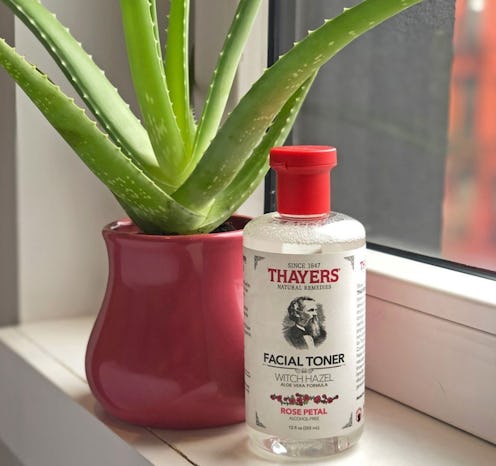(Skin Care)
Witch Hazel Is The Old-School Ingredient Your Skin Care Routine Needs Now
It’s back in style.

For a time, witch hazel had become maligned in the beauty world. The ingredient is a plant-derived astringent that has a history in folk medicine, where it was, historically, used to create teas and ointments. So, why did it get a bad rep? Simply put, it was, for a long time, “overused or incorrectly used, leading to overly-stripped skin,” explains board-certified dermatologist Dr. Ranella Hirsch to TZR. Nowadays, however, formulations have evolved, and products containing witch hazel often also include hydrating ingredients — to mitigate any of those stripping effects before they even happen. And when that’s the case, it turns out witch hazel is actually a great ingredient to have in your skin care arsenal.
A quick review on what witch hazel does for your skin — and why it can actually be a useful tool. Astringents are often used to cleanse skin, tighten pores, and dry out excess oil, but, as mentioned, can also be drying when not well formulated. The ingredient is beneficial for managing excess oil (and that goes not only for facial skin, but also for the skin on your scalp!), and is also known for “relieving inflammation, suppressing redness, and soothing sensitive skin,” notes board-certified dermatologist Dr. Cory Hartman to TZR. “Alcohol is largely being removed from the extraction process and there are now many witch hazel products that are completely alcohol free,” he says, explaining that “it is a common misconception that witch hazel naturally contains alcohol, but the astringent properties actually come from the naturally-occurring tannins” found in the plant. Still, the addition of “hydrating ingredients like aloe vera and glycerin balance those drying properties,” and are often included in newer formulas.
As for who should use it, it’s generally recommended for oilier skin types. Dermatologists often recommend it to their patients with oily or combination skin, though, according to board-certified dermatologist Dr. Dendy Engelman, who told TZR it can also be a great option for “patients who are pregnant and need a treatment for their acne because they can’t use salicylic acid or retinoids.” Engelman is especially a fan of the ingredient used in toners for after cleansing — and there are more great options in this category than ever before. One more perk of the ingredient? It’s often found in super affordable formulas, making it an easy way to boost your skin’s glow without spending a ton of money.
Below, discover the new generation of witch hazel products and what they can do for your skin and scalp:
We only include products that have been independently selected by TZR's editorial team. However, we may receive a portion of sales if you purchase a product through a link in this article.